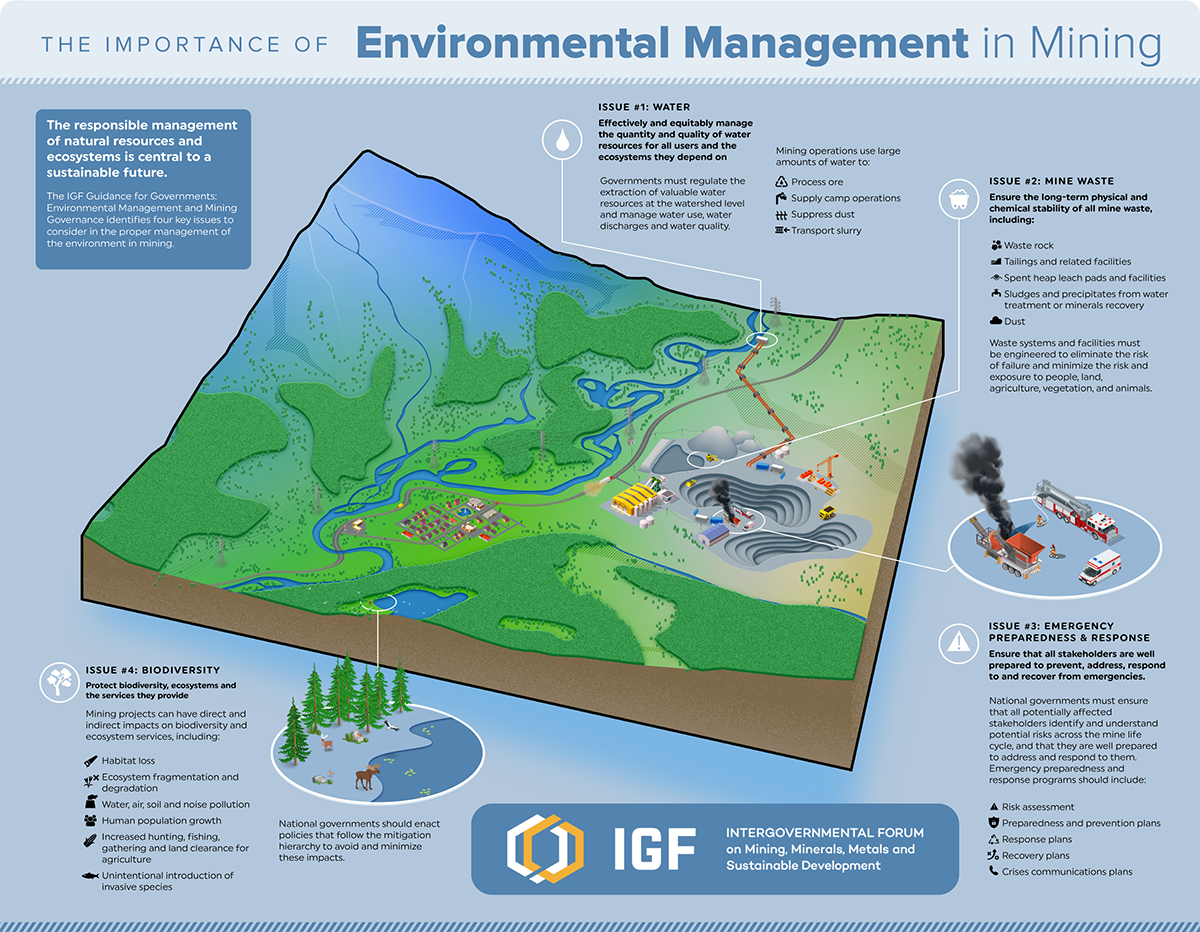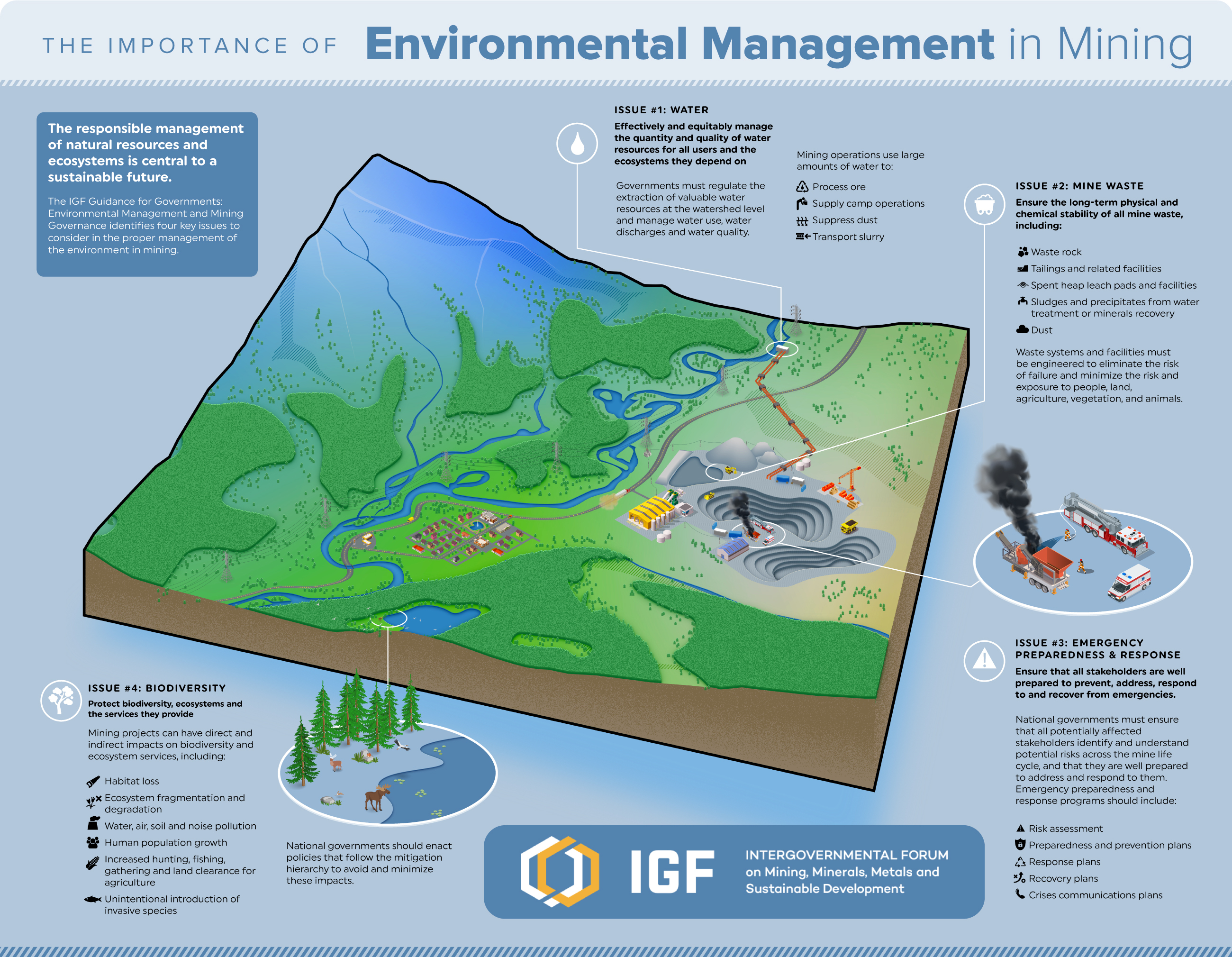Visualizing the Importance of Environmental Management in Mining
The following content is sponsored by the Intergovernmental Forum on Mining “IGF”.
View the full-size version of this infographic.
The Importance of Environmental Management in Mining
A mine will always impact the environment, but the question is to what degree?
The responsible management of natural resources and ecosystems such as soils, plants, animals, water and air, and the services they provide, is central to the efforts of any society seeking to become more sustainable.
The Intergovernmental Forum on Mining “IGF” has identified four issues that governments could effectively manage to reach sustainability goals.
- Water Management
- Biodiversity and Ecosystem Services
- Mine Waste Management
- Emergency Preparedness
These four key issues are critical for governments and communities to consider to ensure mining and the environment can coexist for the benefit of all.
Issue #1: Water Management
According to the IGF, U.S. mining operations used 5,526 million cubic meters of water, amounting to 1% of the country’s total water use in 2015.
Mining is a very water intensive industry. In mineral processing, slurry transport, dust suppression, and to meet the water needs of employees, large-scale mining operations use significant amounts of groundwater and surface water across the mine life cycle.
Mining operations need water to process ore and run camp operations. Mines also need to manage water that comes in contact with operations, through rainfalls and runoff.
The protection of water resources applies to both surface and groundwater, and these water resources are increasingly under strain due to:
- Climate change
- Variable precipitation
- Growing populations, increased industrial and agricultural activity
Competing demands for water resources from the mining sector, agriculture, households, from other industries and sectors, and for conservation and leisure—ensure that governments will always play a critical role in water management throughout the life of a mine, not only at the site itself but across watersheds and beyond national borders.
Issue #2: Biodiversity and Ecosystem Services
Mining projects have the potential to impact biodiversity and ecosystem services throughout their lifecycle. Understanding how mining can impact biodiversity is vital to mitigate the harmful impacts of mining on the biodiversity and ecosystem
Biodiversity delivers many benefits to their surrounding communities known as ecosystem services—and a mining project has direct and indirect impacts before, during and after mining operations on these services.
Direct Impacts:
- Habitat loss
- Ecosystem fragmentation and degradation
- Water, air, soil and noise pollution
Indirect Impacts:
- Human migration seeking opportunities
- Increased hunting, fishing, gathering and land clearance for agriculture
- Unintentional introduction of invasive species to an ecosystem
Governments, when considering the merits of a proposed mining project, will have to weigh the economic and development needs of the country and the local community against its conservation and environmental goals.
Issue #3: Mine Waste Management
Mining moves and processes large amounts of materials to extract metals. The excess material is known as mine waste. Mine wastes can contain minerals that are reactive which could be released from the rock when it is mined, crushed, and exposed to air and water.
Mine waste makes up the largest amount of material that is mined. The strip ratio defines how much waste rock there is compared to valuable ore. For example, a 2:1 strip ratio means that mining one tonne of ore will require mining two tonnes of waste rock.
Waste management in mining is complex and incorporates a range of disciplines, including geology, geochemistry, civil engineering, and geotechnical engineering.
Waste rock storage facilities, leach pads, and tailings storage facilities are large structures that must be carefully engineered to ensure they are stable over time and the safety of workers and the public.
Governments should set international standards within their own jurisdictions to ensure the proper construction and maintenance of waste rock facilities.
Issue #4: Emergency Preparedness
Emergency preparedness involves understanding the likelihood of an emergency situation and its potential consequences, taking proactive action to prevent the hazard, preparing to mitigate emergency effects, responding appropriately, communicating effectively, and recovering afterwards.
This relates to:
- Industrial emergencies
- Natural and climate-related disasters
- Health emergencies
- Political and security risk
Governments have a strong role to play in emergency preparedness, ensuring that responses are swift, organized and coordinated, and that all relevant stakeholders, from local communities to staff, are safe and protected.
Resources and Communities
Mineable deposits occur in both convenient and inconvenient places, close to or distant from communities, close to or distant from water sources, and close or distant from farm land or ecologically sensitive areas.
Mining will always have an impact. The active and sustainable management of these natural resources before, during, and after mining will help to avoid negative impacts where possible and could even mean excluding mining.
A failure to manage the four issues of mining on the environment can threaten the viability of operations, but can also undermine the relationships between a mining company, affected communities, and all levels of government.
The Intergovernmental Forum on Mining “IGF” is creating the policy framework to address the importance of environmental management in mining.
-

 Sponsored3 years ago
Sponsored3 years agoMore Than Precious: Silver’s Role in the New Energy Era (Part 3 of 3)
Long known as a precious metal, silver in solar and EV technologies will redefine its role and importance to a greener economy.
-

 Sponsored7 years ago
Sponsored7 years agoThe History and Evolution of the Video Games Market
Everything from Pong to the rise of mobile gaming and AR/VR. Learn about the $100 billion video games market in this giant infographic.
-

 Sponsored8 years ago
Sponsored8 years agoThe Extraordinary Raw Materials in an iPhone 6s
Over 700 million iPhones have now been sold, but the iPhone would not exist if it were not for the raw materials that make the technology...
-

 Sponsored8 years ago
Sponsored8 years agoThe Industrial Internet, and How It’s Revolutionizing Mining
The convergence of the global industrial sector with big data and the internet of things, or the Industrial Internet, will revolutionize how mining works.



